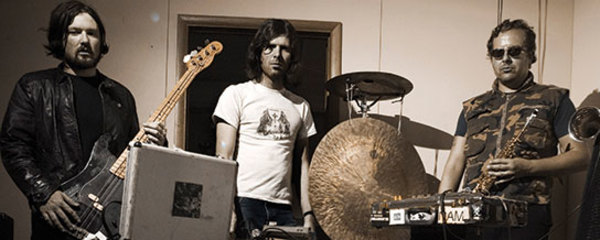Wolf Eyes In The Studio
Five years ago, I emailed Wolf Eyes to request some of their records for my […]
Wolf Eyes In The Studio
Five years ago, I emailed Wolf Eyes to request some of their records for my […]

Five years ago, I emailed Wolf Eyes to request some of their records for my college radio show. In the package that erstwhile member Aaron Dilloway sent, wedged between a hand-scrawled note and hand-colored Nautical Almanac and Wolf Eyes vinyl, were a bunch of ads for products from Korg and Roland, likely torn from a music gear trade mag. But what was embedded on Wolf Eyes hardly resembled something made in a crisp and clean studio on the latest pro-audio offerings. Rather, the shrieking vocals, subsonic pulses, and metal-on-metal scrape-squeals seemed like they could only come from one place: a gritty basement (in Detroit? Ann Arbor?) filled with ripped-apart synths, radios, and ghosts of technology past.
Wolf Eyes’ raison d’être hasn’t veered much from those days, but their inimitable sound certainly has gained them a following; their latest, Human Animal (their second LP for Sub Pop, the first since Dilloway departed the band) has got even the most conservative of indie rock hipsters singing the praises of dirty noise. We tapped Wolf Eyes co-founder Nate Young, and current member John Olson, to give us a glimpse into what makes the wolf really howl.
XLR8R: Does Wolf Eyes have a regular studio, per se?
John Olson: No, we’ve got a computer with Pro Tools on it; that’s it. We used to have a studio, but now it’s more just a room… nothing fancy at all. Dread was recorded off the back of Nate’s amp, direct to MiniDisc in one take. [For Human Animal] we laid down almost all the tracks on our home studio, and brought them to [Brendan Gillen of Ectomorph] to help us beef them up.
A lot of people think that what you guys do is sort of random.
JO: There’s nothing random about it.
Is there a goal in mind?
JO: We were like, “We wanna write a slow jam,” so we took some acoustic drum bits and pieces and crab sounds, and we made it into “Rationed Rot.” It’s all homogenized sounds, kind of reorganized.
Did you say “crab sounds?”
JO: Yeah, they were from old Folkways records and sound effects records and things like that.
Do you use a lot of samples?
JO: I wouldn’t necessarily call them samples. It’s more like “needed” sound. We’re not really around crabs and stuff like that, but we’ll crinkle cans to try to get a sound we want. But, like, the basis of the rhythm for “Rationed Rot” is a recording I have of a dog with heart murmurs. But we’re not into it for the environmental or humane things; we just liked the sound.
For the live show, do you look for the sturdiest gear?
Nate Young: [We use] the cheapest stuff possible. We use a lot of Behringer mixers and Radio Shack mixers, and that is actually a lot of our setup: feedback run through a ton of different mixers.
You make a lot of gear, right?
NY: One thing I always get a lot of sounds from in the studio is just an average radio, rewired so that it doesn’t pick up any stations. It just kinda picks up a shortwave signal.
The typical brands you find in other studios in your arsenal, too?
NY: Not really. The fellas have been laying off the effects and the pedals lately, just kinda dealing more with rawer sounds, like tape manipulation and mic’ing pieces of metal. Name brands have kinda dropped off our map [laughs]. I have, like, a DOD delay that… I don’t prefer it–I just think it’s easier. I prefer a nice, thick tape delay but, as far as traveling and just out of utility, I think it’s fine. When we record, we fine-tune it and maybe get rid of standard plug-ins that we’re using for a slap back and put a nice reverb on there or something.
So you do use digital effects…
NY: Yeah, we definitely implement them, just as a utility, and then take them away. And then we’ll go into a studio that has nicer effects, nice tape delays, and spring reverbs and stuff. What else we use is that Bi-Filter from Electro-Harmonix. That’s something we use on the drums a lot to get it real nice and thick.
What’s your favorite musical tool in your studio?
NY: Personally, it’s just my oscillators, my electronics. I enjoy those the most. Though recently I’ve been playing just a spring reverb that’s been extremely effective.
What’s the most important ingredient in a Wolf Eyes studio session?
NY: Probably a liquor store within walking distance.

